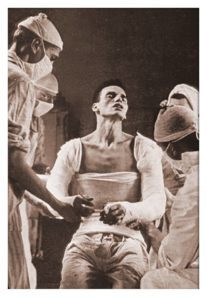History of Plaster of Paris immobilization
Plaster of Paris has been used for centuries to treat fractures by immobilizing bones and allowing undisturbed healing.
During World War II, the incidence of pressure ulcers in young injured soldiers increased as a result of plaster body casts and immobilization splints. Plaster-of-Paris has been used for centuries to treat fractures by immobilizing bones and allowing undisturbed healing. For injuries to the spinal column it believed that plaster splints prevented hemorrhage and delayed contracture related to paresis. In World War II, plaster used on a large scale not only to stabilize fractures but also to facilitate safe evacuation of the wounded soldier by ambulance or train, therefore used in the evacuation hospital close to the site of battle as well as in the general hospital to prepare for the long journey home. The main goal was to relieve pain and prevent further damage to the fracture site, and decrease occurrence of secondary hemorrhage at the site of the fracture. At that time, Plaster immobilization applied in field conditions, often without the benefit of x-rays and by combat medics without training in orthopedics.

